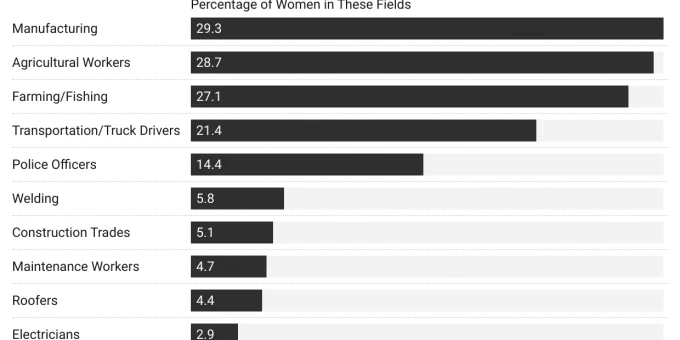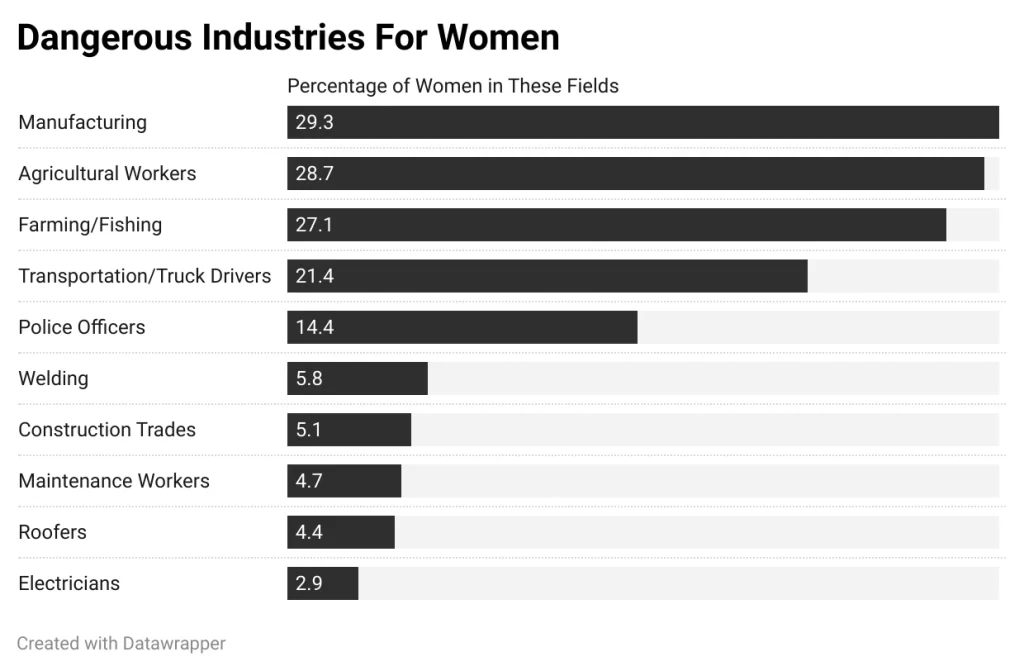
INDIANA – An eye-opening analysis provided by DeMayo Law Offices identifies the industries posing the most significant risks to women’s safety in the workplace. The report, Women in High-Risk Industries: Addressing Safety and Gender-Based Challenges, sheds light on disturbing patterns of harassment, discrimination, and inadequate safety protocols, particularly in male-dominated fields such as manufacturing, agriculture, transportation, and construction.

The findings underline the systemic challenges women face in these industries, from harassment and violence to physical safety hazards. Below are key insights from the report, highlighting the intersection of gender-based issues and workplace safety.
Manufacturing: Harassment Outpaces Representation
While women make up just 29.3% of the manufacturing workforce, they file 32% of harassment claims, according to 2021 data from the Equal Employment Opportunity Commission (EEOC). Alarmingly, the reporting gap is wide—only 30% of harassment incidents in male-dominated industries are reported due to fears of retaliation (Harvard Business Review, 2022).
Agriculture: Gendered Risks and Fatalities
Women make up 28.7% of the agricultural workforce but face unique risks, especially in terms of sexual harassment and exposure to harmful chemicals. Forty percent of female farmworkers report experiencing sexual harassment, while Latina farmworkers are disproportionately affected by pesticide exposure (National Agricultural Workers Survey, 2020). Women working in the fields while balancing childcare responsibilities are also twice as likely to suffer injuries involving heavy machinery (CDC/NIOSH).
Transportation & Trucking: Isolation and Assault
In the transportation and trucking industries, where women represent only 21.4% of the workforce, harassment is a pressing issue. A 2023 survey by the Women In Trucking Association revealed that 53% of female drivers reported verbal harassment, and 12% faced physical assault. However, companies implementing gender-neutral restrooms and GPS panic buttons have seen a 35% reduction in harassment incidents (American Trucking Association, 2022).
Construction: PPE and Fatalities Pose Major Risks
Despite making up just 5.1% of the construction workforce, women face disproportionate risks in this field, including ill-fitting personal protective equipment (PPE) that increases the chances of falls and lacerations (CPWR, 2021). Women also account for a small percentage of construction fatalities. Still, the risk of fatal falls for women is significantly higher compared to their male counterparts, with women facing fatal fall rates of 17% versus 11% for men (OSHA, 2023).
Teaching: Threats and Mental Health Strain
In education, where women make up a significant portion of the workforce, 29% of K-12 teachers report threats or physical violence from students (National Center for Education Statistics, 2022). Female educators also face higher rates of burnout, with 67% linking it to unsafe or hostile work environments (RAND Corporation, 2023).
Healthcare: Rising Workplace Violence
Healthcare workers, particularly nurses, face alarming levels of violence. Nonfatal violence injuries in the healthcare sector rose by 63% from 2019 to 2022, with nurses being five times more likely to be assaulted than other workers (BLS, 2023). Shockingly, half of these assaults go unreported due to the normalization of violence in healthcare settings (Journal of Emergency Nursing, 2021).
Social Work: Assaults and Policy Gaps
Social workers also face considerable risks, with one in four reporting physical violence in 2022. LGBTQ+ social workers experience even higher rates of violence. Additionally, only 15% of agencies provide trauma training for field workers, leaving many vulnerable to harm (CSWE, 2022).
Cross-Sector Insights: A Call for Reform
The report reveals a concerning trend of intersectionality in workplace violence. Women of color and LGBTQ+ women face two to three times higher rates of harassment and violence compared to their white, cisgender counterparts (EEOC, 2023). Workplace violence also carries a significant economic impact, with employers incurring an estimated $20 billion annually in turnover and legal fees (National Safety Council, 2023).
A spokesperson for DeMayo Law Offices commented on the findings, stating, “Many industries still fail to provide safety measures tailored to women, whether it’s properly fitting PPE or enforcing anti-harassment policies. Our analysis found that women often face both physical and emotional risks in these fields, making the need for workplace reforms more urgent than ever.”







.png)











